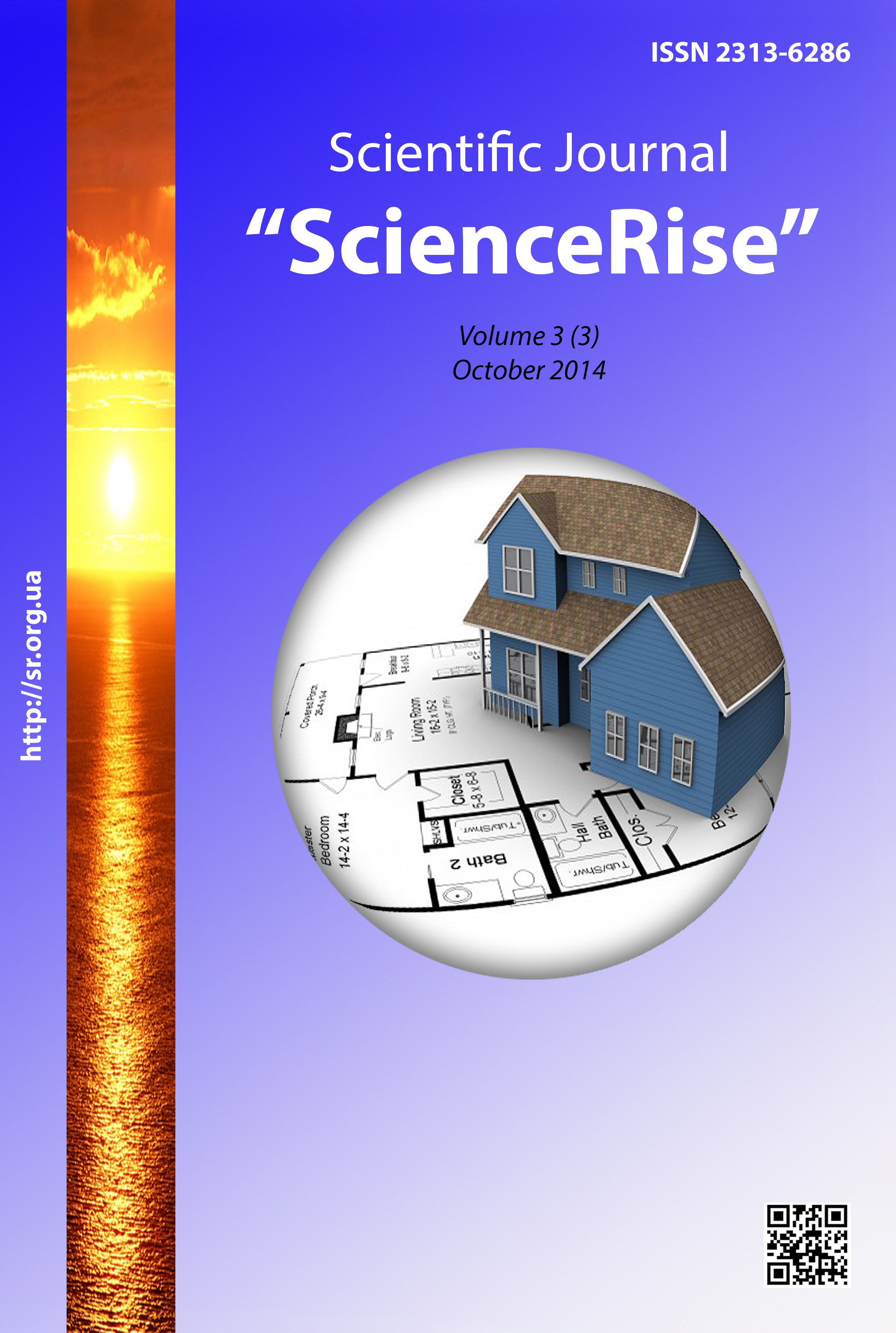Concrete based on alkaline slag portland cement: features of modifying and performance
DOI:
https://doi.org/10.15587/2313-8416.2014.27999Keywords:
alkali activated slag Portland cement, heavy concrete, surface-active agent, capillary porosity, frost resistanceAbstract
To control performance properties of heavy concrete, including frost resistance, is possible only by means of regulation of its pore structure. The purpose of research was to identify relationship between parameters of porosity and frost resistance of concrete depending on composition of alkali activated slag Portland cement and chemical nature of surfactants.
References
1. Dhir, R. K. (2005). Cement: a question of responsible use //Proceed. Int. Conf. held at the University of Dundee [“Cement combination for durable concrete”]. Scotland, Thomas Telford, UK, 1–12.
2. Usherov-Marshak. A. V. (2004). Slag Portland cement and concrete. Kharkov, Colorite, 154.
3. Runova, R. F., Gots, V. I., Nazarenko, I. I. (2008). Structural materials of new generation technology and their introduction into the construction. Kiev, EksOb, 360.
4. Gelevera, A. G., Munzer, Kamel (1994). Alkaline portland and slag portland cements First Int. conf. on alkaline cements and concretes. Kiev, 173–180.
5. Gluhovskyi, V. D. (1959). Gruntosilikaty. Kiev, 120.
6. Krivenko, P. V., Petropavlosky, O. N., Gelevera, A. G. (2007). Alkaline Portland cements with high volumes products of man-make and natural origin. Proceed. Int. Conf. “Alkali Activated Materials”. Prague, Czech Republic, 413–427.
7. Pushkarova, E., Gonchar, O., Bondarenko, O. (2007). Quick hardening alkaline blast furnace cements: specific features of hydration and hardening. Proceed. Int. Conf. “Alkali Activated Materials”. Prague, Czech Republic, 565–580.
8. Stark, J., Wicht, B. (2004). Dauerhaftigkeit von Betons. Schriften der HAB Weimar- Universität, 282.
9. Krivenko, P. V., Petropavlovskii, O. N., Vozniuk, G. V., Pushkar, V. I. (2010). Cunstructive properties of the concretes made with alkali-activated cements of new generation. First Intern. Conf. on Advances of Chemically-activated Materials. Jinan, Shandong, China, 139–146.
10. Krivenko, P. V., Runova, R. F., Rudenko, I. I. (2012). Alkaline cements and concretes on the world and domestic construction market: regulation framework, especially the properties and prospects of development. Proceedings of the Scientific-practical conference. Kiev, Budindustriya LTD, 95–104.
11. Pushkarova, K. K., Bondarenko, O. P. (2011). Concrete based on alkali slag Portland cement modified with complex additives. Scientific Papers. Rivne, 62–67.
12. DSTU B V.2.7-181:2009 Alkiline cement. Specifications (2009). National standard of Ukraine.
13. DSTU В V.2.7-171:2008 (EN 934-2:2001, NEQ) Additives for concrete and mortar. General specifications (2008). National standard of Ukraine, appropriate EN 934-2:2001 “Admixtures for concrete, mortar and grout Part 2: Concrete admixtures – Definitions, requirements, conformity, marking and labelling”.
14. DSTU B V.2.7-170:2008. Building materials. Concretes. Methods for determining the average density, moisture content, water absorption, porosity and water resistance (2008). National standard of Ukraine). Kiev.
15. DSTU B V.2.7-47-96. Building materials. Concretes. Methods for determining the frost resistance. General specifications (1996). Moscow.
Downloads
Published
Issue
Section
License
Copyright (c) 2014 Володимир Іванович Гоц, Раїса Федорівна Рунова, Раїса Федорівна Рунова, Ігор Ігорович Руденко, Ігор Ігорович Руденко, Олесь Васильович Ластівка, Олесь Васильович Ластівка, Ярослав Олександрович Говдун, Ярослав Олександрович Говдун

This work is licensed under a Creative Commons Attribution 4.0 International License.
Our journal abides by the Creative Commons CC BY copyright rights and permissions for open access journals.
Authors, who are published in this journal, agree to the following conditions:
1. The authors reserve the right to authorship of the work and pass the first publication right of this work to the journal under the terms of a Creative Commons CC BY, which allows others to freely distribute the published research with the obligatory reference to the authors of the original work and the first publication of the work in this journal.
2. The authors have the right to conclude separate supplement agreements that relate to non-exclusive work distribution in the form in which it has been published by the journal (for example, to upload the work to the online storage of the journal or publish it as part of a monograph), provided that the reference to the first publication of the work in this journal is included.

